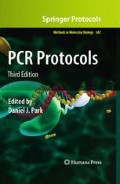Abstract
PCR represents an extremely powerful and central molecular biology method. At the heart of its power is the exquisite sensitivity offered: single molecule detection in certain contexts. However, with great power comes great responsibility. Contamination of reagents or test samples with amplifiable material, such as previous reaction products, can be crippling to scientists applying PCR protocols. Prevention of PCR contamination is far and away preferred over eradication. This chapter sets out to offer guidance as to how to use PCR while minimising contamination problems.
Access this chapter
Tax calculation will be finalised at checkout
Purchases are for personal use only
References
Halfon, P., Khiri, H., Gerolami, V., Bourliere, M., Feryn, J.M., Reynier, P., Gauthier, A., and Cartouzou, G. (1996) Impact of various handling and storage conditions on quantitative detection of hepatitis C virus RNA. J. Hepatol. 25, 307–11.
Anderson, S.C. and Cockayne, S. (2003) Clinical Chemistry: Concepts and Applications. McGraw-Hill, New York.
Wilson, C.L. (ed.) (2007) Microbial Food Con-tamination, Second Edition. CRC, Boca Raton.
Kemp, B.M. and Smith, D.G. (2005) Use of bleach to eliminate contaminating DNA from the surface of bones and teeth. Forensic Sci. Int. 154, 53–61.
Prince, A.M. and Andrus, L. (1992) PCR: how to kill unwanted DNA. Biotechniques 12, 358–60.
Sarkar, G. and Sommer, S.S. (1990) Shedding light on PCR contamination. Nature 343 (6253), 27.
Schuurman, T., van Breda, A., de Boer, R., Kooistra-Smid, M., Beld, M., Savelkoul, P., and Boom, R. (2005) Reduced PCR sensitivity due to impaired DNA recovery with the MagNA Pure LC total nucleic acid isolation kit. J. Clin. Microbiol. 43, 4616–22.
The 10 categories of HCRW WHO Healthcare waste management (HCWM). (Accessed January 25, 2010, at http://www.healthcarewaste.org/en/128_hcw_categ.html).
Longo, M.C., Berninger, M.S., and Hartley, J.L. (1990) Use of uracil DNA glycosylase to control carry-over contamination in polymerase chain reactions. Gene 93, 125–8.
Niederhauser, C., Höfelein, C., Wegmüller, B., Lüthy, J., and Candrian, U. (1994) Reliability of PCR decontamination systems. PCR Methods Appl. 4, 117–23.
Author information
Authors and Affiliations
Corresponding author
Editor information
Editors and Affiliations
Rights and permissions
Copyright information
© 2011 Humana Press
About this protocol
Cite this protocol
Khan, Z. (2011). Setup of a PCR Laboratory. In: Park, D. (eds) PCR Protocols. Methods in Molecular Biology, vol 687. Humana Press. https://doi.org/10.1007/978-1-60761-944-4_1
Download citation
DOI: https://doi.org/10.1007/978-1-60761-944-4_1
Published:
Publisher Name: Humana Press
Print ISBN: 978-1-60761-943-7
Online ISBN: 978-1-60761-944-4
eBook Packages: Springer Protocols

